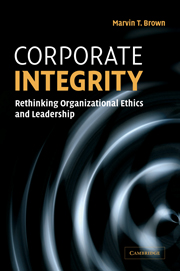Book contents
- Frontmatter
- Contents
- Preface
- 1 The context for corporate integrity
- 2 Cultural integrity as openness
- 3 Interpersonal integrity as relational wholeness
- 4 Organizational integrity as pursuing a worthwhile purpose
- 5 Social integrity as civic cooperation
- 6 Environmental integrity as natural prosperity
- 7 Corporate integrity and organizational leadership
- Appendix: Assessment worksheets
- Bibliography
- Index
2 - Cultural integrity as openness
Published online by Cambridge University Press: 05 September 2012
- Frontmatter
- Contents
- Preface
- 1 The context for corporate integrity
- 2 Cultural integrity as openness
- 3 Interpersonal integrity as relational wholeness
- 4 Organizational integrity as pursuing a worthwhile purpose
- 5 Social integrity as civic cooperation
- 6 Environmental integrity as natural prosperity
- 7 Corporate integrity and organizational leadership
- Appendix: Assessment worksheets
- Bibliography
- Index
Summary
As stated in the preface, the designing of corporate integrity employs a civic perspective, focuses on relationships, and uses a method of examining and changing communication patterns. This chapter outlines the method. From the post office model of communication, examining and improving communication appears fairly simple. Just say things more clearly or get better feedback. From the contextual perspective, things get a bit more complicated. How can you change what is going on when you are part of it? It certainly is not possible without awareness, and awareness requires the possibility of reflection. Reflection occurs when we switch from automatic pilot, so to speak, to a conscious appreciation of what is going on. Such appreciation does not take us out of communication patterns, but it does change our attitude toward them. Once we have achieved this new awareness, we can examine and even change them.
In most situations, people do what they think is right considering the world they think they live in. Once we have figured out how things work in a particular setting, most of us get by fairly well. What is right is dictated by the situation. This sounds like moral relativism, which assumes that what is right depends on culture. The method presented here assumes that persons do act in the various communication patterns that constitute their culture. So, on the one hand, the method does not rely on some abstract, universal position from which one can judge the validity of different cultural norms.
- Type
- Chapter
- Information
- Corporate IntegrityRethinking Organizational Ethics and Leadership, pp. 37 - 68Publisher: Cambridge University PressPrint publication year: 2005



